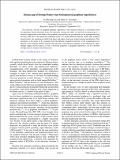Energy gap of Kronig-Penney-type hydrogenated graphene superlattices
Author(s)
Lee, Joo-Hyoung; Grossman, Jeffrey C.
DownloadLee-2011-Energy gap of Kronig-Penney-type.pdf (543.8Kb)
PUBLISHER_POLICY
Publisher Policy
Article is made available in accordance with the publisher's policy and may be subject to US copyright law. Please refer to the publisher's site for terms of use.
Terms of use
Metadata
Show full item recordAbstract
The electronic structure of graphene-graphane superlattices with armchair interfaces is investigated with first-principles density-functional theory. By separately varying the widths, we find that the energy gap Eg is inversely proportional to the width of the graphene strip and that the gap increases as the hydrogenated strip becomes wider due to the enhanced confinement effect. It is further demonstrated that, unlike other graphene nanostructures, the superlattices exhibit both direct and indirect band gaps without external perturbations. This peculiarity in the nature of Eg originates from the different connection structures of the symmetrized wave function at the boundary between adjacent unit cells due to the reflection symmetry of the superlattices. These findings suggest that the optical as well as electronic properties of graphene superlattices can be controlled through selective chemical functionalization.
Date issued
2011-09Department
Massachusetts Institute of Technology. Department of Materials Science and EngineeringJournal
Physical Review B
Publisher
American Physical Society
Citation
Lee, Joo-Hyoung, and Jeffrey Grossman. “Energy Gap of Kronig-Penney-type Hydrogenated Graphene Superlattices.” Physical Review B 84.11 (2011): [4 pages]. ©2011 American Physical Society.
Version: Final published version
ISSN
1098-0121